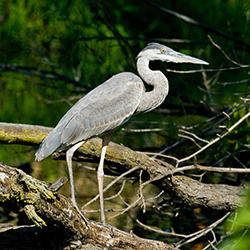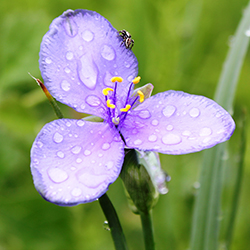At Chautauqua National Wildlife Refuge, the Illinois River’s natural cycle is mimicked to create a stopover for migrating birds and wildlife enthusiasts alike.
For Mike Miller, the sights are twofold. There are the birds themselves: 700 pelicans silently flying into Chautauqua Lake; 100,000 snow geese taking off; or 10,000 mallards quacking simultaneously—“a hilarious sound,” he adds. Then there are the looks on people’s faces. “When you’re leading a tour and you see a very stoic Midwesterner jumping up and down because they’re seeing these sights… those connections really are priceless.” As supervisor of environmental and interpretative services at the Peoria Park District and president of Peoria Audubon Society, Miller leads two public birding tours each year along the Illinois River, with stops at Chautauqua National Wildlife Refuge in Havana, an internationally-renowned breeding ground for migratory birds, fish and other wildlife.
Mastering the Flood
The Illinois River has long been a major thoroughfare for waterfowl and other migratory birds heading south from their breeding grounds to warmer winter homes. Located just across the river from Emiquon National Wildlife Refuge, Chautauqua provides a diverse habitat of wetlands, swamps and woodlands—the perfect respite for weary winged travelers. “From a bird’s-eye perspective, [the Emiquon-Chautauqua complex] offers a huge, huge landing pad,” says Miller. “From a habitat point of view, it’s very attractive to the birds.” But it hasn’t always been.
While flooding in the Illinois River Basin has been common for centuries, so too, were the dry-outs. As the floodwaters receded, important plants flourished in the moist soil, nourishing birds passing by. But when this land was diked, drained and converted to agricultural production in the 1920s, large deposits of river silt decimated aquatic life in backwater lakes like Lake Chautauqua. The dry-outs grew less common, the floods more challenging.
“It’s unpredictable,” says Bob Barry, who manages Chautauqua, Emiquon and the Meredosia National Wildlife Refuge, about 60 miles downriver. “[If] you get a four-inch rain in Chicago and the river floods, it can wipe out everything we established in the early part of the season. If it floods for too long, we don’t have the opportunity to grow the food the waterfowl needs.”

Barry became refuge manager a few years ago, attracted by the waterfowl. He rattles off the species he works to protect like a coveted client list: pintails, shovelers, green- and blue-winged teals, great and snowy egrets, pectoral and stilt sandpipers, killdeer, warblers, red-tailed hawks, osprey… and so on. But he gushes equally over the locale.
The Stephen A. Forbes Biological Station at Chautauqua is the oldest inland field station in North America and one of nine field stations of the Illinois Natural History Survey, guardian of the state’s biological resources. More importantly, Barry suggests, it houses the Frank C. Bellrose Waterfowl Research Center, named for “the preeminent waterfowl biologist back in the early days of establishing wildlife refuges and looking at the ecology of birds.”
Among his many career accomplishments, Bellrose was a “master of aerial inventories”—using light aircraft to develop a more comprehensive account of large flocks, and radar to document major migratory movements. Today, his legacy endures in the work of Barry and others at the U.S. Fish and Wildlife Service (USFWS), who share a passion for managing this unique and challenging eco-labyrinth.
The “Natural” Paradox
With the purchase of the Chautauqua Drainage and Levee District in 1936, Lake Chautauqua became part of the National Wildlife Refuge System. Today, the levee system around Chautauqua’s two pools keeps away most major floods, allowing the USFWS to focus on influencing vegetation to attract various fowl.
Barry recounts the cycle by the birds’ arrivals, which begin with an influx of songbirds—warblers and orioles—in May and June. In early July, the USFWS begins drawing down the lakes to maximize the moist-soil vegetation needed to attract shorebirds—like sandpipers and stilts—through August. Come October, it’s time to start flooding the lakes again as the teals fly in. The refuge brims with waterfowl—ducks, swans, geese—through November, and after a frozen winter, they return in March. Repeat cycle.
Without the levees, this land would be subject to frequent flooding like anywhere else along the river, and there wouldn’t be much opportunity for those waterfowl. “It’s counterintuitive: you put up levees to make the area more natural,” Barry says, chuckling at the paradox. “But we have to keep some of the flooding out to make it like it used to be… We have more management capabilities now, and we’re better able to mimic the natural system inside the levees.”
This management mentality sets Chautauqua apart. “There is diversity here,” Miller stresses. “If you’re driving from Peoria south towards Banner… you’re going through not only some different habitats, but different management strategies.” The Pekin Lake Conservation Area, for example, is geared toward active recreation, managing water levels “so birds are there during the hunting season… [and] fish are there during fishing season.” To the southwest, Spring Lake State Fish and Wildlife Area is managed for both active and passive recreation, including activities like picnicking and birdwatching.
Then there are private refuges and access areas, with differing objectives based on the purview of their owners. Finally, the National Wildlife Refuge System isadministered for the conservation, management and restoration of fish, wildlife and plant resources—like “producing the most food possible for birds during migration,” Barry explains. “If hunting pressures get too heavy in the areas where hunting is allowed, it gives them a place to go for refuge.”
isadministered for the conservation, management and restoration of fish, wildlife and plant resources—like “producing the most food possible for birds during migration,” Barry explains. “If hunting pressures get too heavy in the areas where hunting is allowed, it gives them a place to go for refuge.”
Naturally, Chautauqua is full of other wildlife as well, including deer, coyotes, beavers and river otters. Its numerous trails and observation areas offer visitors a chance to experience this diversity—also embraced during Miller’s spring and fall tours.
“It’s amazing the way [the USFWS] manipulates the water levels… You’ll get a hundred thousand snow geese and tens of thousands of ducks,” he says. “And when those birds all decide to take off at once, you can hear the wingbeats for miles away.” a&s


